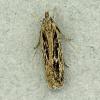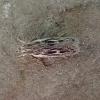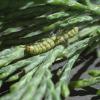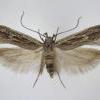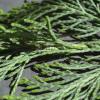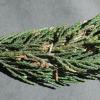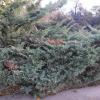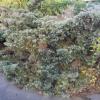35.099 Gelechia senticetella (Staudinger, 1859)
Status and Distribution
First found in the British Isles in 1988, in Essex, presumably as an adventive species introduced with imported plant material. Has since spread strongly to the north and west with records (up to 2021) reported from South Yorkshire, Staffordshire and Somerset. There is an isolated record from Devon in 2008. It is widespread and common within its core central south-eastern area.
Provisional map
Foodplant and Larval Feeding Signs
Juniperus spp. (juniper), see plant distribution map; Chamaecyparis and Cupressus spp. (cypress) including Chamaecyparis lawsoniana (lawson cypress) and Thuja sp (red-cedar).
In Europe also found on Juniperus phoenicea, J. excelsa, J. foetidissima, J. sabina, J. oxycedrus, J. thurifera and Cupressus semerpvirens.
Feeding starts with the small larva mining leaves followed by the spinning of silken tubes among the leaflets and feeding on the leaves and in the buds.
Finding the Moth
Larva: in autumn the small larva mines the leaflets followed by the creation of silk tubes (sometimes affixed to the central stem of a frond) in late autumn from where the larva feeds on leaflets and inside buds, exiting its tube to feed at night.
Adult: comes readily to MV light.
Similar Species
The head of Gelechia senticetella has the frons (front) whitish and the vertex (top) reddish brown. There is a dark costal spot at the base of the forewing.
Anarsia lineatella is usually more strongly streaked with black on the forewings, which are grey in colour (brownish-grey in G. senticetella) and has a subquadrate mark on the costa, which is variable in size and shape, about half way along. This feature is absent in G. senticetella. The large and dense tuft of projecting scales present on segment two of the palps in this species are present to a lesser extent in Gelechia senticetella and G. sabinellus. Worn or non-bred specimens may require dissection if there is any doubt.
Gelechia sabinellus (a rare species last recorded in Britain in 2004) is larger (wingspan 15-18mm as opposed to 10-13mm), more greyish and often has the longitudinal black streaks in the forewing interrupted by two light spots.
In Europe the species shows remarkable external variation believed to be associated with the foodplant utilised by the larva and includes some that lack the strong streaking found in the British Isles. Additionally specimens encountered in Europe have a larger wingspan range (12-16mm) which suggests the size difference between it and G. sabinellus may potentially not as distinctive as suggested above.
Single brooded from late June to early September.

